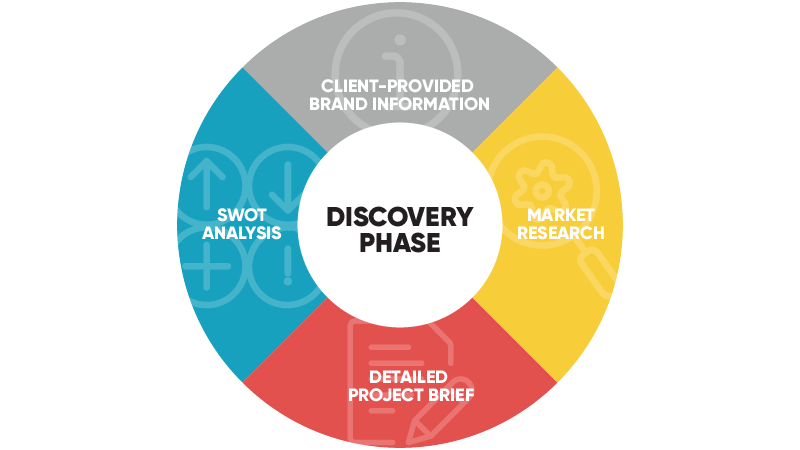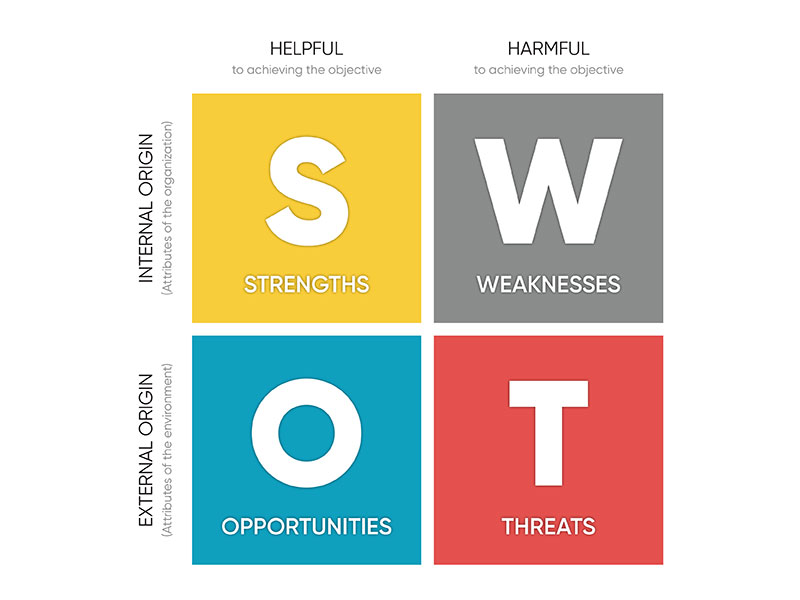SWOT Analysis: Strength, weakness, opportunity and threat. A simple yet effective strategic planning technique, it can guide the goal-setting process for any client or business program.
This blog post will outline the best practices to develop a SWOT analysis that will allow you to identify areas that are experiencing success and areas that need some improvement. A thorough and honest analysis of the subject at hand will help kick-start your organization’s strategic planning.
A Little Bit of Planning Goes a Long Way
It can be easy to fall into the trap of starting a project at lightning speed without first taking time to solidify your goals and develop a plan. But, without a goal, you’ll end up going on a reckless, winding trip with no GPS and no final destination. To ensure program success, we always recommend beginning with a discovery phase.

This stage is critical to establishing a strong foundation for your project and includes outlining goals and objectives. Take the time to identify and digest all available data that is relevant to the specific results you want to achieve with this project. A SWOT analysis will help define your client or company’s current positioning in relation to the end goal or desired achievement.
SWOT Analysis Components
A SWOT analysis is a high-level summary that details your business’s strengths, weaknesses, opportunities and threats at the time you conduct the analysis. A SWOT analysis allows you to holistically assess the current state of your business—including both the internal and external factors that impact your business performance—so that you can plan strategically for a better future.
Strengths
Factors within an organization that lead to its unique standing among competitors
Sample Questions to Uncover Strengths
- Why do customers like us?
- What is the one thing we do best?
- What do we do better than our top competitor?
- What makes our company a place where someone would want to work?
- What makes us unique?
Weaknesses
Factors within an organization that need improvement and hinder it from reaching its full potential
Sample Questions to Uncover Weaknesses
- What do customers complain about?
- What does our top competitor do better than us?
- Why wouldn’t someone want to work with us?
- Are we wasting money on something that does not help drive sales?
- Why do we lose sales?
Strengths and weaknesses are factors of internal origin including human capital, resources and brand awareness. Opportunities and threats are external elements out of our control, such as the state of the economy and market trends.
Opportunities
External factors that could be maximized for the benefit of the organization.
Sample Questions to Uncover Opportunities
- What’s the latest and greatest trend in our business?
- What else can we offer customers?
- What are new platforms we can utilize to market ourselves?
- Are there companies outside of our business line that we can partner with?
- What are new technologies we can use to be better and faster?
Threats
External factors that put the organization at risk and need to be mitigated.
Sample Questions to Uncover Threats
- Who is doing business better than us?
- What trends are going against what our business offers?
- What is occurring in the economy that could affect our costs?
- What are competitors doing now that we are not?
- What obstacles are we facing?

Take the Time To Do It Right From the Start
Starting a project is often the hardest phase of a project altogether, but having a plan from the start is not just helpful—it’s critical.
A SWOT summary is not the only planning framework, of course, but it is a powerful high-level analysis that assists at a project’s infancy. There is also SOAR (strengths, opportunities, aspirations, results), which works similarly—perhaps with a more positive spin—and other frameworks like gap planning that compare where an organization is now, where it wants to be and how the “gap” should be filled to reach goals.
There’s no right or wrong choice for the framework you choose to use—research and experiment with the framework that works best for your organization. But a SWOT analysis is a great place to start as it will simplify your planning process to get the hard part “right” from the beginning.
Our Top 4 SWOT Tips
Practice makes perfect. Here are our recommendations when implementing a SWOT analysis:
- Start with a clear purpose. What is the key project/goal/KPI you are working toward? Don’t lose focus of this when filling in your SWOT summary.
- Get team members involved. Ask applicable members to complete a SWOT, then come together to see what similarities and differences stand out. Identify as a team the common themes in each category.
- Create a SWOT analysis at least annually. By doing so, you will see if any weaknesses have moved off the list or even turned into a strength. Plus, consider whether there are new competitors in your business line that you need to add to your threats.
- A SWOT analysis is just the beginning! It’s not a “set it and forget it” idea. After you’ve identified the key items in each category, follow through with a plan that has clearly defined deliverables, KPIs and due dates.
Need some ideas to catalyze your SWOT brainstorm session, or facing financial barriers in your strategic planning process? Check out these articles: “Virtual Brainstorming and Whiteboarding Sessions” and “Where to Invest and Where to Cut Back When Budgets Are Tight.”
This blog post was originally published on August 13, 2019, by Misty Sutton and has been updated and republished.



